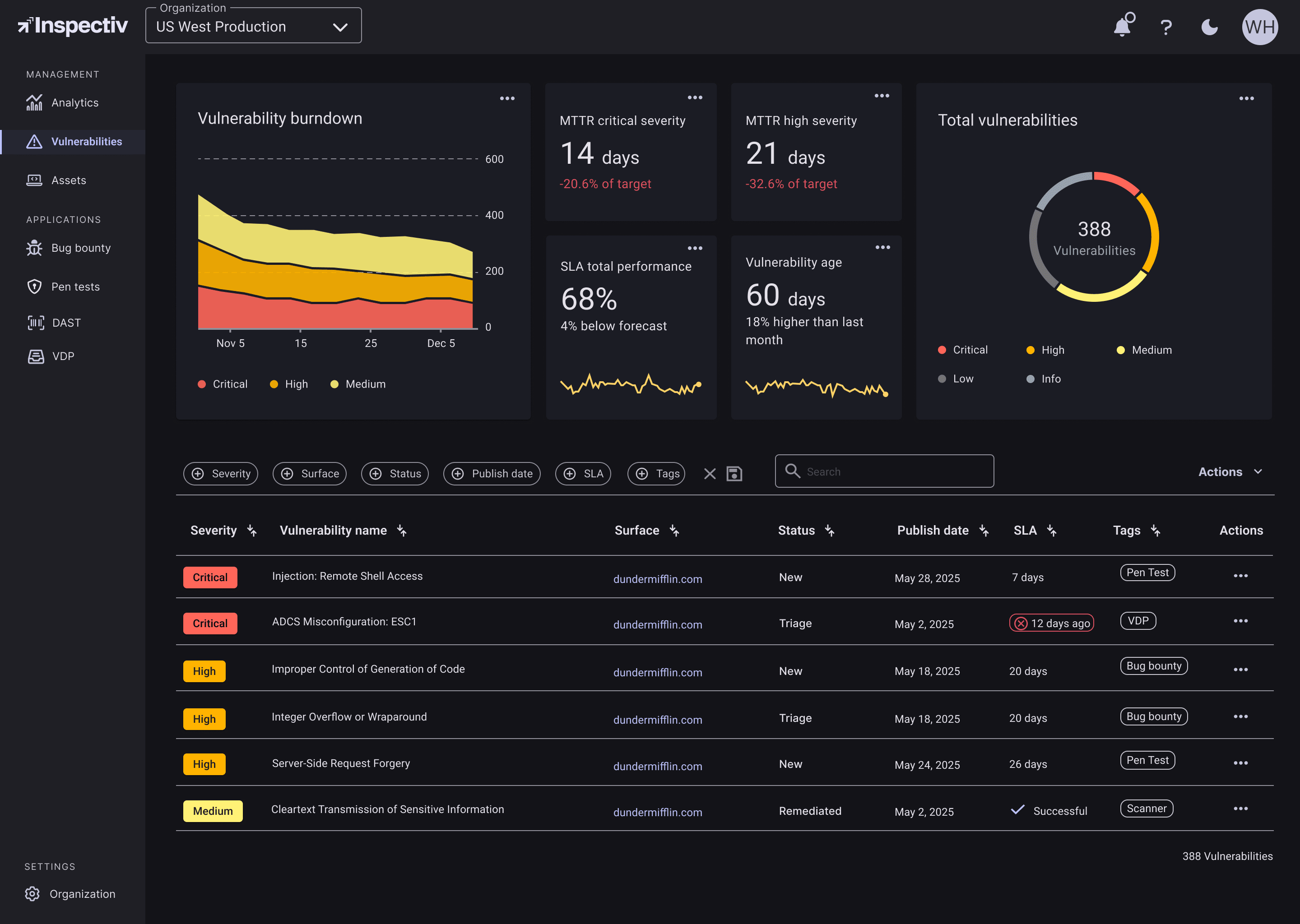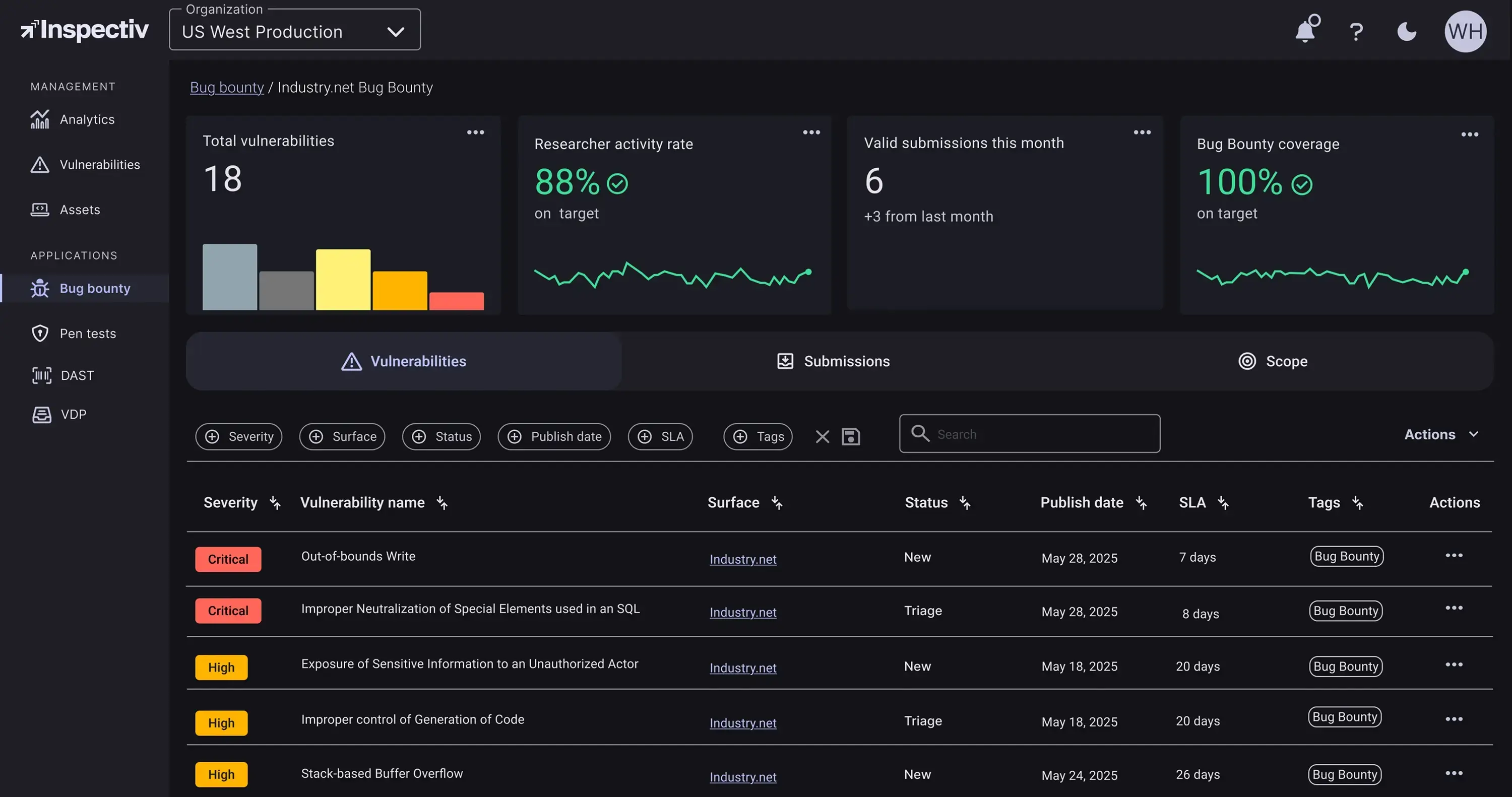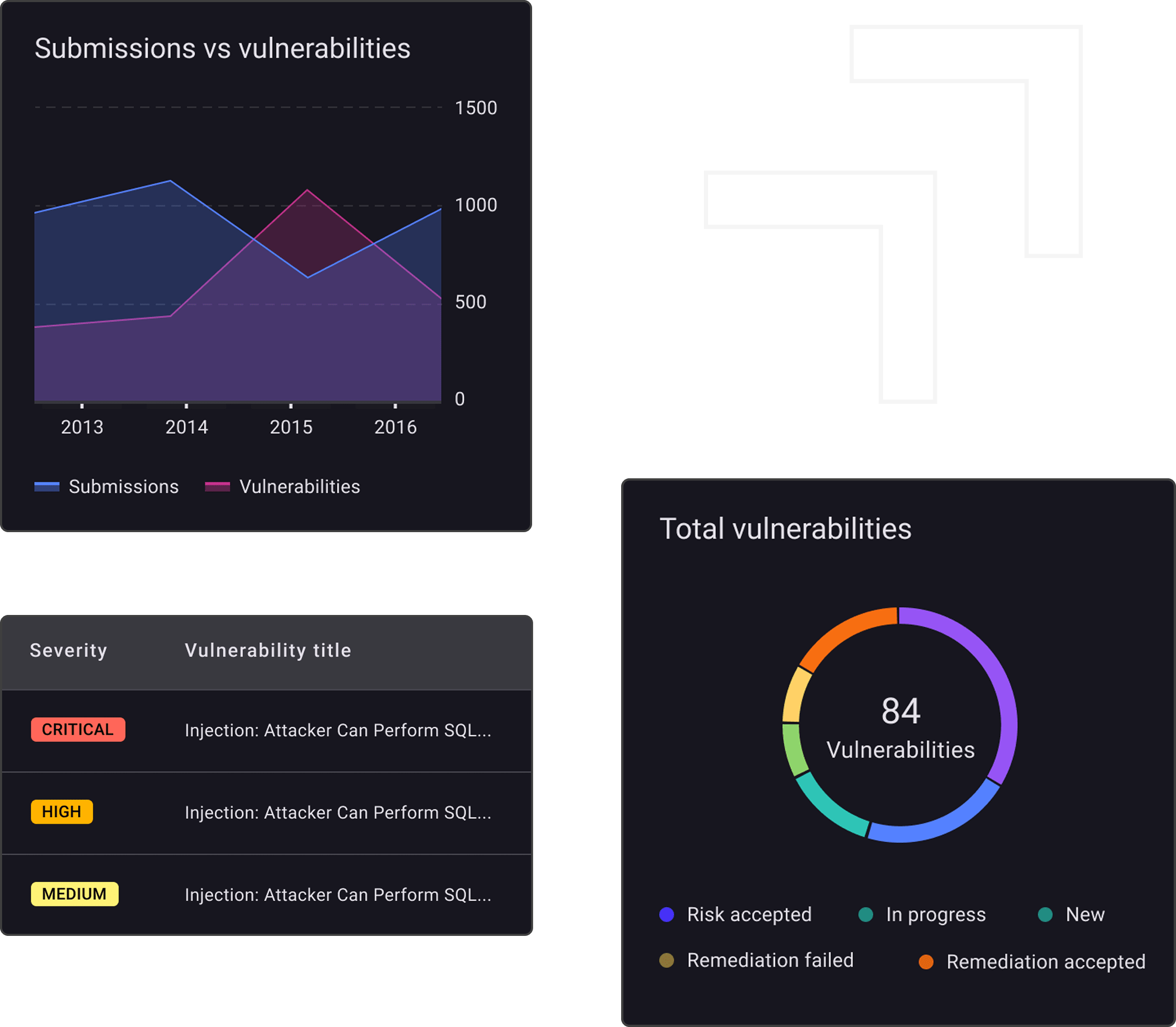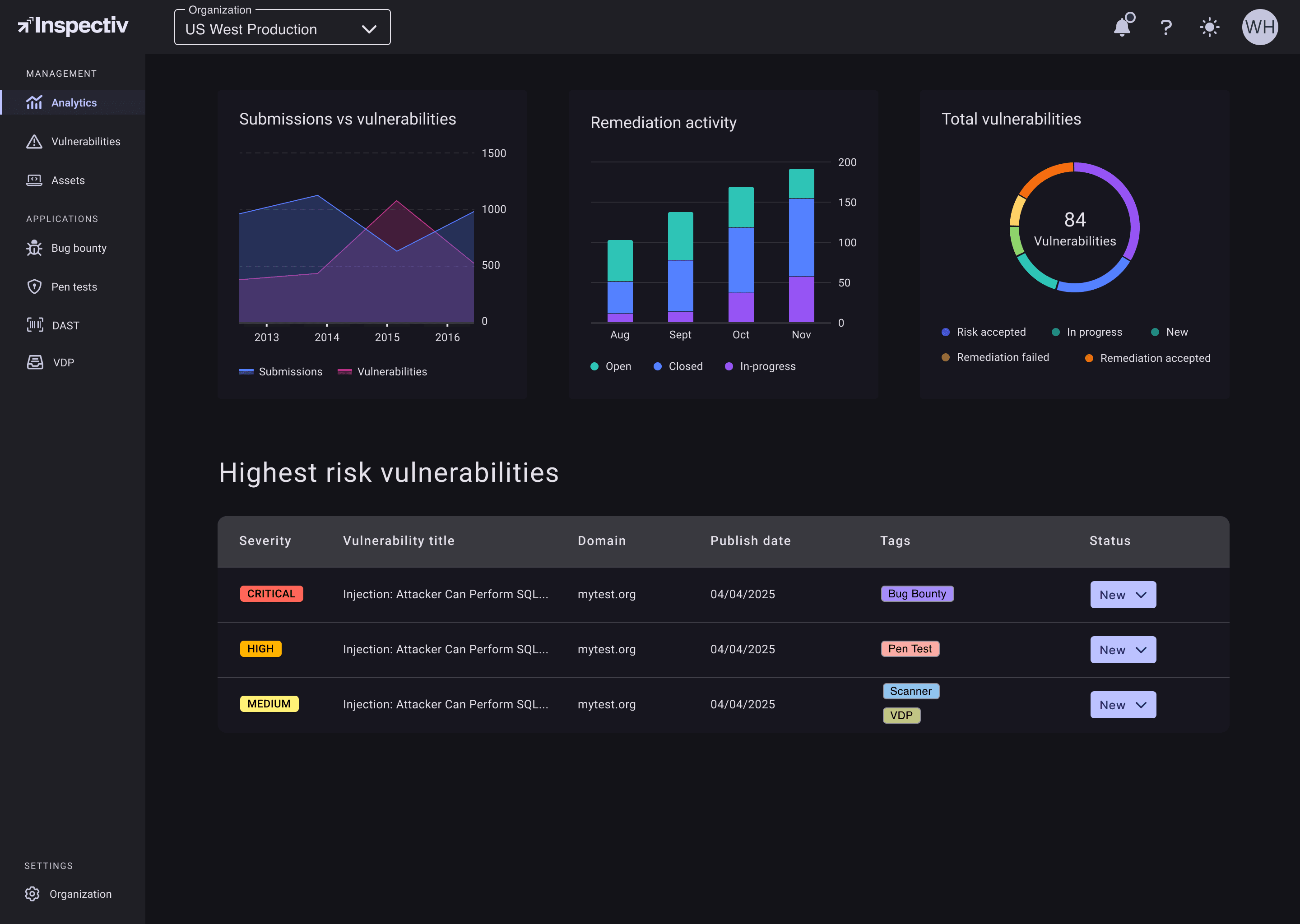Platform
Manage and remediate vulnerabilities with real-time dashboards, integrations, and expert validation.
Platform
Manage and remediate vulnerabilities with real-time dashboards, integrations, and expert validation.

See Inspectiv in Action!
Schedule a live demo to see how our platform helps you manage vulnerabilities, reduce noise, and stay compliant.

See Inspectiv in Action!
Schedule a live demo to see how our platform helps you manage vulnerabilities, reduce noise, and stay compliant.
Get expert-led, 24/7 testing from curated researchers, triage support you can trust, and results that matter, all with flat-fee pricing and no operational overhead.

Traditional bug bounty programs are noisy, unpredictable, and hard to manage. Inspectiv changes that. Our managed program pairs top-tier researchers with human-vetted vulnerability findings to surface only validated, high-impact findings.
Every submission is replicated before it reaches your developers, and every fix is re-tested. No guesswork. No wasted time. Just continuous, scalable security testing backed by flat-fee pricing you can trust.
A bug bounty program is a proactive approach to security testing that invites ethical hackers, also known as security researchers, to uncover and report vulnerabilities in your applications, APIs, and infrastructure. In return, researchers are rewarded with bounties based on the severity and impact of their findings. It’s a powerful way to extend your coverage and discover issues that traditional testing often misses. Inspectiv supports both private and public Bug Bounty programs, giving you the flexibility based on your risk tolerance and program maturity. Many teams start with a private program to maintain tighter control, then expand to a public program for broader attack surface coverage and deeper insights.
For teams juggling compliance requirements, limited bandwidth, and expanding attack surfaces, Inspectiv makes bug bounty manageable. We handle all researcher communications, replicate every submission, validate each finding for accuracy, and provide clear remediation guidance.
The result? Continuous security insights without the chaos delivered through a streamlined platform and supported by transparent, flat-fee pricing.


Inspectiv’s Bug Bounty is designed to fit directly into your DevSecOps workflows, so your team can move fast without sacrificing security. Real-time findings are routed to the tools your developers already use, such as Jira, Slack, APIs and webhooks, making it easy to assign, track, and remediate vulnerabilities as part of your existing process. With streamlined collaboration and clear remediation guidance, Inspectiv helps you act on what matters, when it matters.


Inspectiv stands apart from other pentesting providers by combining expert-led testing with real-time triage, flexible retesting, and seamless integrations, all within a unified vulnerability management platform. Every engagement includes curated researchers matched to your environment, customized testing plans, validated findings prioritized by risk, and built-in remediation tracking. With on-demand retesting, workflow integration, and predictable pricing, Inspectiv delivers faster, more actionable results without the noise or overhead of legacy penetration testing services.
Inspectiv's bug bounty programs are powered by a global community of experienced security researchers who specialize in identifying real-world vulnerabilities across modern environments. From web applications and APIs, these researchers continuously test your systems, serving as an always-on extension of your security team and uncovering risks that automated tools often miss. Our triage team creates structured scopes with clear rules of engagement, managing all communication from scope management to payouts, while our unified platform gives security teams complete visibility into vulnerability trends, testing activity, and remediation progress across their entire security program.
All researcher interactions are handled by Inspectiv behind the scenes, so you can take full advantage of a thriving security community without adding extra work to your team.

.png)


%20Logo%20(1).png)
.png)
.png)








Inspectiv's bug bounty programs are powered by a global community of experienced security researchers who specialize in identifying real-world vulnerabilities across modern environments. From web applications and APIs, these researchers continuously test your systems, serving as an always-on extension of your security team and uncovering risks that automated tools often miss. Our triage team creates structured scopes with clear rules of engagement, managing all communication from scope management to payouts, while our unified platform gives security teams complete visibility into vulnerability trends, testing activity, and remediation progress across their entire security program.
All researcher interactions are handled by Inspectiv behind the scenes, so you can take full advantage of a thriving security community without adding extra work to your team.
Inspectiv’s unified platform brings together Bug Bounty, Pentesting, DAST, and VDP into a single, streamlined system that gives security teams continuous visibility across their entire attack surface. Findings from each testing method are validated, prioritized, and centralized, making it easy to track remediation, prove compliance, and respond faster to emerging threats. By consolidating insights across multiple testing layers, Inspectiv enables a true defense-in-depth strategy that reduces noise, surfacing real risk, and helping teams stay ahead of vulnerabilities before they become breaches.





Pentesting provides point-in-time validation. Bug bounty programs extend your reach with ongoing vulnerability discovery. Together, they create a continuous security testing strategy that helps you meet compliance and reduce risk.
Want full coverage? Bundle Inspectiv’s Bug Bounty Program with our Pentest as a Service (PTaaS).
Traditional bug bounty platforms can create more work than they solve by flooding your team with noisy reports, inconsistent researcher quality, and unpredictable costs. Inspectiv simplifies the process with a fully managed approach that puts control, clarity, and confidence back in your hands.With Inspectiv, you get continuous vulnerability discovery without the operational burden.
Our triage team validates and replicates every submission, so your developers only see what matters. We handle all researcher communications, payouts, and retesting, freeing your internal team to focus on fixing issues, not managing logistics. And with flat-fee pricing, there’s no guesswork. You know exactly what you’re paying with no escrow, no bounty surprises. Inspectiv turns bug bounty into a reliable, scalable layer of your AppSec strategy, helping you find more critical vulnerabilities, reduce risk faster, and scale securely.
Schedule your personalized demo to see how Inspectiv can streamline your security testing, reduce your risk, and meet compliance all with one powerful platform.
